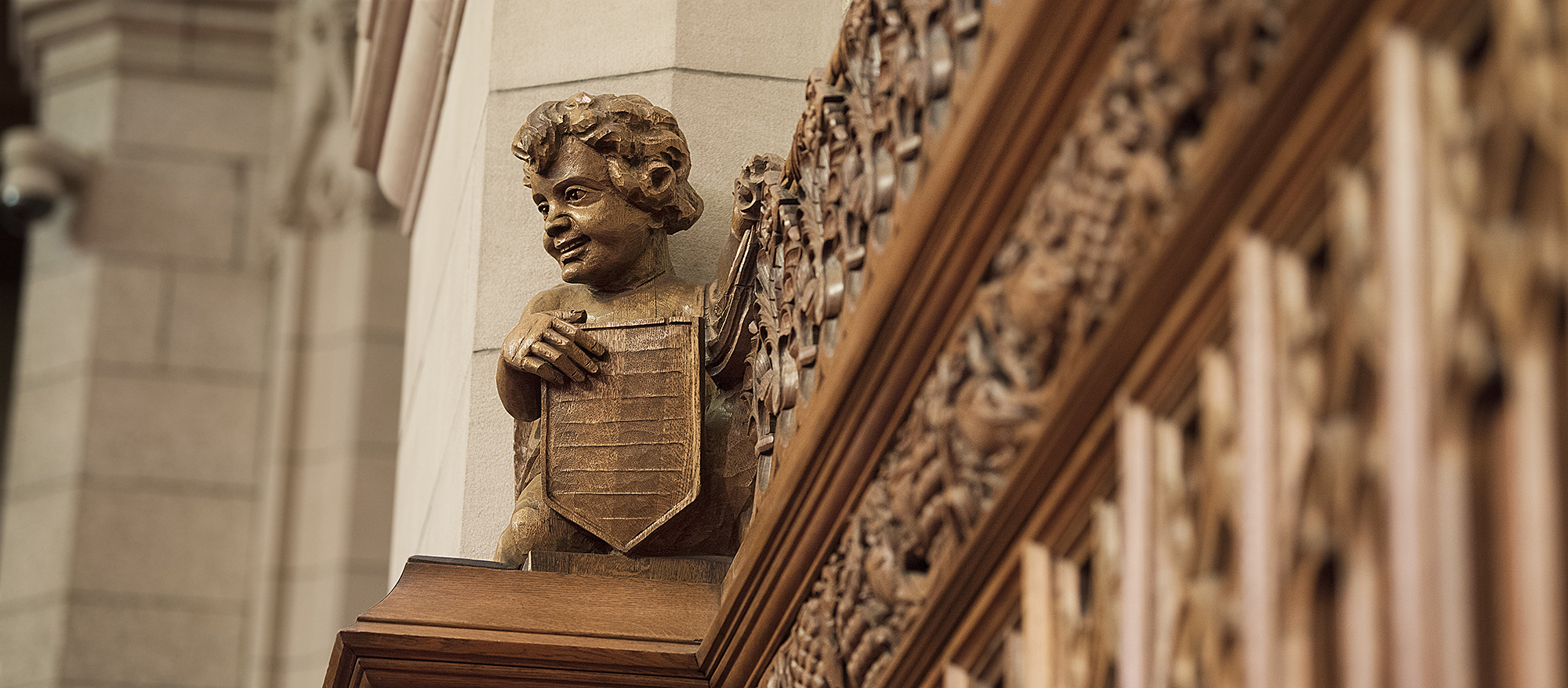The Hill’s Heavenly Host: Parliament’s supernatural creatures, part three

In the third of a series of four articles, we look at three supernatural creatures you’ll encounter in Parliament Hill’s Centre Block.
In February 2019, the Senate moved to the Senate of Canada Building, a former train station built in 1912. The Senate will occupy this temporary location while Parliament’s Centre Block — the Senate’s permanent home — is rehabilitated.
Although Centre Block is shuttered for rehabilitation work, Canadians can still experience its art and architecture — as well as the Senate of Canada Building’s — through the Senate’s immersive virtual tours.
Parliament Hill is home to demonic and divine beings — to be clear, we’re talking about artworks here — but a century-long truce has kept them in their respective corners.
While Centre Block’s wild and whimsical depictions of dragons, monsters, gargoyles and grotesques grab most of the attention, their celestial counterparts make a modest and dignified appearance in a few key spots.
Mourning angels guard the Books of Remembrance in the Peace Tower. Light-hearted, childlike putti watch over proceedings in Centre Block’s Senate Chamber. The brooding figure of Poseidon, Greek god of the sea, holds court in the soaring rotunda at the heart of Centre Block.
“These figures appeal to the better spirits of our nature,” House of Commons Curator Johanna Mizgala said. “They remind parliamentarians of their responsibilities and of the higher principles that should prevail in this place.”
We met Parliament’s demon hordes earlier in this series. Now let’s meet its heavenly host:

Poseidon
One of the 12 Olympian gods of ancient Greek mythology, Poseidon holds dominion over the seas, storms and earthquakes. Like the forces of nature he personifies, Poseidon can be moody and unpredictable.
He appears in Confederation Hall, Centre Block’s main entrance foyer, carved into the central column. Here he commands the waves, surrounded by seafaring motifs. Marble floor tiles form a stylized mariner’s compass. The encircling sea is represented by a wavy band of green marble sourced from the Greek island of Tinos.
The central column represents the federal government, holding firm while waves crash against it. A ring of encircling pillars, firmly anchored to the central column, represents the provinces.
It’s about having a trusted pilot at the helm, Ms. Mizgala said.
“The fundamental idea is that no matter how stormy things get, good government and order will keep the ship of state on a steady course.”
In ancient legends, it was critical not to antagonize Poseidon. He could be a seafarer’s most powerful protector or his most terrifying adversary. Seen in this light, Poseidon is a good luck talisman — invoked here in stone to ensure the safe voyage of the ship of state.

Angels
Angels play a crucial role in the Peace Tower’s Memorial Chamber, a vaulted three-storey chapel dedicated to honouring Canada’s war dead. This is Parliament Hill’s most hallowed space, described by Centre Block architect John A. Pearson as a “sacred grove in the middle of the forest.”
At its centre, a limestone altar supports the First World War Book of Remembrance, which records the names of more than 66,000 Canadians killed in action during the Great War. The book’s bronze, enamel, and glass presentation case, crafted in 1927, features statuettes of kneeling angels at each corner. The angels mourn the fallen, stand guard over them in the afterlife, and embody the Remembrance Day pledge, “We will remember them.”
When this chapel was built, angels were very much alive in the public imagination, symbolically expressing how many felt about a war that had destroyed so much and taken so many lives. This wartime obsession with angels began at the outset of fighting, with battlefield reports of ghostly medieval archers, led by the figure of St. George, coming to the aid of British soldiers. The fact that the first account appeared as a short story in the London Evening News did little to hamper its widespread acceptance.
First World War recruitment posters depicted winged angels urging troops into battle or invoked real-life “angels of mercy,” such as the Red Cross nurses who tended wounded soldiers within range of the front line. This reflected a widespread belief that angels — spiritual and real — were actively intervening on the side of Britain and its allies.
The Memorial Chamber’s angels are products of these fervently spiritual times. They serve as symbolic guardians and sombre reminders of wartime sacrifice.

Putti
Sixteen chubby angelic children, called putti, crouch at the base of the limestone pilasters surrounding Centre Block’s Senate Chamber, smiling beatifically upon the debates taking place below.
Putti have their roots in classical mythology, where the Greek god Eros — whose Roman counterpart is Cupid — caused people to instantly fall in love by piercing their hearts with his enchanted arrow. In the Renaissance, this pagan god of love morphed into the red-cheeked Christian angel known as a putto and began to be portrayed in groups rather than a single figure.
Putti are the embodiment of love, innocence and goodness but also suggest related concepts of kindness, civility and self-control. On Parliament Hill, they are symbols of decorum, a check on flaring tempers and a gentle reminder of parliamentary etiquette.
“In the context of Parliament,” Ms. Mizgala notes, “they’re about encouraging your better impulses, your higher ideals and your sense of duty.”
Read more in our series about Parliament Hill’s supernatural creatures:








